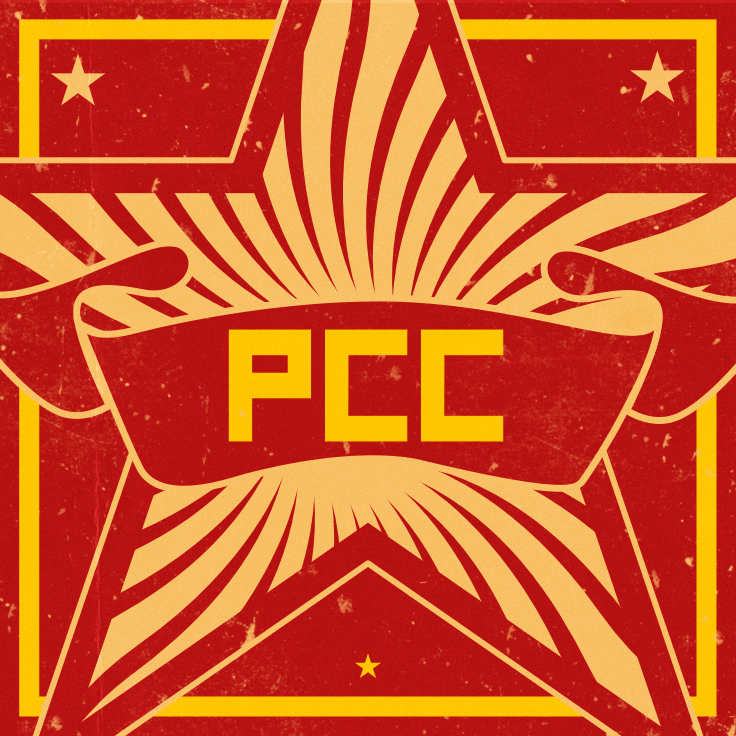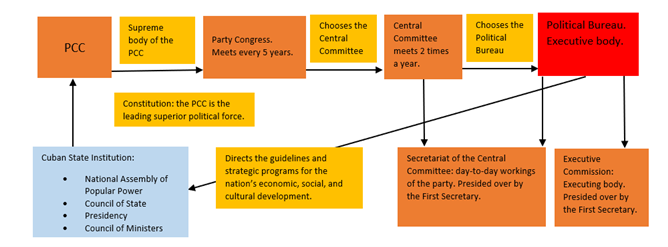Aldo Álvarez
The Cuban Single-Party System: A Primer on the PCC in the Exercise of Power in Cuba

In Cuba, only one political party is legally recognized: The Cuban Communist Party (PCC). According to the typology developed by Sartori,[1] one of the great political scientists of the 20th century, single-party systems are considered non-competitive, along with hegemonic parties in multiparty systems, as was the case with the PRI in Mexico during much of the 20th century. The author makes this classification based on the rules that establish the possibilities of achieving political power from fair and egalitarian terms, among the different political positions that can arise from a country’s population.
The existence of a single-party system in Cuba was championed by Fidel Castro on several occasions. One of them was in 1991,[2] when he said that multi-partyism would lead to the political fragmentation of the country, and that an undeveloped society, especially one under siege, could not afford to be divided if it wanted to develop.[3] He explained: “I have the deepest conviction that the existence of one party is and must be, for a long period of history that no one can predict until when, the form of political organization for our society.”[4]
Currently, Article V of the Cuban Constitution of 2019 describes the PCC as “the superior leading political force of the society and the State.” This phrase was almost identically included in both the 1976 Constitution and in the first national conference of the PCC in 2012.[5] It is thus clear that the unique party system in Cuba, recognized constitutionally, considers the party as an entity superior even to the structure of the Cuban State and its society. In this scenario we ask ourselves:
What is the structure of the PCC like? How does important, political decision-making work in Cuba? How are these decisions interrelated with the rest of Cuba’s governmental structure?
First, let’s identify how the PCC is structured:
According to the Statutes of the PCC,[6] the Party Congress “is its supreme body and decides on all the most important questions of the party’s politics, organization, and activity,” and also “approves the strategic guidelines and programs for economic, social, and cultural development of the nation.” Therefore, if the PCC is the “superior leading political force,” and the Congress is its “supreme body,” then it follows that the Party Congress, which is regularly convened every 5 years, is the most important political event in political life in Cuba.[7]
In the periods between the celebration of one Congress and the next, and by its representation, the Central Committee is the highest governing body of the party. The Central Committee meets ordinarily only 2 times a year.
Its plenary, that is, its members gathered in assembly, elects the Political Bureau–or politburo–from among its members, including the First and Second Secretaries of the Party. This Political Bureau, in representation of the Central Committee, is then designated as the “superior body of direction of the party between the plenary sessions of the Central Committee and directs all the partisan work during these periods.”
Finally, this Political Bureau, made up of people who most of the time occupy another public office, is expected to create an executive commission for their day-to-day activities, as well as “in relation to the day-to-day running of the party, the Political Bureau is supported by the Secretariat of the Central Committee.”
So we have:
- The Party Congress – Supreme body – meets every 5 years.
- The Central Committee – Representative body – meets every 6 months.
- The Political Bureau – Higher management body – meets when convened.
- The Secretariat of the Central Committee and Executive Commission – Works on the day-to-day basis.
We understand that in this complex system of indirect party representation, the best way to support any explanation is through an outline:

For a better understanding the of the Political Bureau, it is important to mention that the majority of its members hold governmental positions in Cuban State Institutions, thus creating a much more complex network of influence, interests, and internal political positions than what the formal structure may reflect.
With this in mind, let’s review who some of the members in the Political Bureau are, which is currently composed of 17 people:[8]
- Raúl Castro Ruz (1st Secretary) (does not have another government position),
- Jose Ramón Machado Ventura (2nd Secretary) (does not have another government position),
- Miguel Díaz Canel (member) (President of the Republic),
- Salvador Valdés Mesa (member) (Vice President of the Republic),
- Esteban Lazo (member) (President of the National Assembly and the Council of State),
- Bruno Rodriguez (member) (Minister of Foreign Affairs),
- Leopoldo Cintra Frías (member) (Minister of the Armed Forces) – along with 2 other vice ministers, this Ministry has the highest representation of a ministerial sector with 3 members in the Political Bureau,
- Marino Murillo (member) (former Minister of Economy and Planning, and recognized during the last decade for being the Head of the Permanent Commission for the Implementation and Development of Cuban socio-economic reforms), and
- Ramiro Valdés, one of the last members of the so-called “historical generation,”[9] former minister of the Ministry of the Interior and Communications (during different periods) and current Deputy Prime Minister.
Taking the above into account, we can conclude that within the Cuban political structure, the Political Bureau is the most important decision-making body in the country. Considering that some of its members also occupy the most important government positions in the nation, it is understood that all the decisions made at its meetings become directly applicable and implemented in the rest of the government’s institutions.
Therefore, those who are members of the Political Bureau participate, with greater or lesser relevance, but always actively and directly, in the country’s most important political decisions.
The contents of Political Bureau meetings are not in the public domain—only a few brief reports are published about them[10]—so citizens only have access to these decisions once they are ready to be shared with the public through public conferences,[11] and later launched by the governmental institutions of the State (Presidency, Council of Ministers, etc.). For these reasons, it is not possible to carry out any detailed analysis of the positions of its members, nor of the internal debates over positions in relation to any topic of interest. However, it is safe to assume, as in any other social group setting, that there must be differences over any idea even though these are not externalized to the public sphere.
Everyone interested in understanding Cuba’s political life a little better should pay close attention to the partisan, generational transfer of power scheduled for the next Party Congress in April 2021 and how this will affect the membership of the Political Bureau in the next political cycle in Cuba (2021-2026).
Not only is the announced retirement of Raul Castro from
public life and his replacement as First Secretary of the Party relevant. In
addition, while the Cuban political system maintains its current form, the
confirmation and permanence, or the substitution and replacement of the other current
members of the Political Bureau, will shape the most important political
decisions to be taken in Cuba over the next several years.
[1] Sartori Giovanni, Partidos y Sistemas de Partidos. Marco para un Análisis. Vol 1. Madrid, Alianza. 1987.
[2] http://www.granma.cu/cuba/2018-08-16/por-que-en-cuba-hay-un-partido-unico-16-08-2018-21-08-04
[3] Alonso Aurelio. The State and Democracy in Cuba. Notes for approximating the problema. Clacso. 2009.
[4] The debate over the pluralist party in Cuba requires an entire independent analysis, taking into account the ample bibliography about the subject.
[5] http://www.granma.cu/granmad/secciones/1ra-conferencia-pcc/objetivos.html
[6] Statutes of the Cuban Communist Party. Articles 45-53.
[7] However, between congresses and for exceptional circumstances No obstante, entre congresos, por razones excepcionales, se puede convocar una Conferencia Nacional, tal como se hizo por primera vez en 2012.
[8] http://www.granma.cu/septimo-congreso-del-pcc/2016-04-19/presentan-nuevo-comite-central-del-partido-19-04-2016-12-04-45
[9] https://tv.vera.com.uy/video/4937
[10] http://www.granma.cu/cuba-covid-19/2020-06-17/efectuada-reunion-del-buro-politico-17-06-2020-00-06-22
[11] http://www.cubadebate.cu/noticias/2020/06/11/gobierno-cubano-informa-medidas-para-la-recuperacion-tras-la-epidemia-de-la-covid-19/
BACK TO NUEVOS ESPACIOS